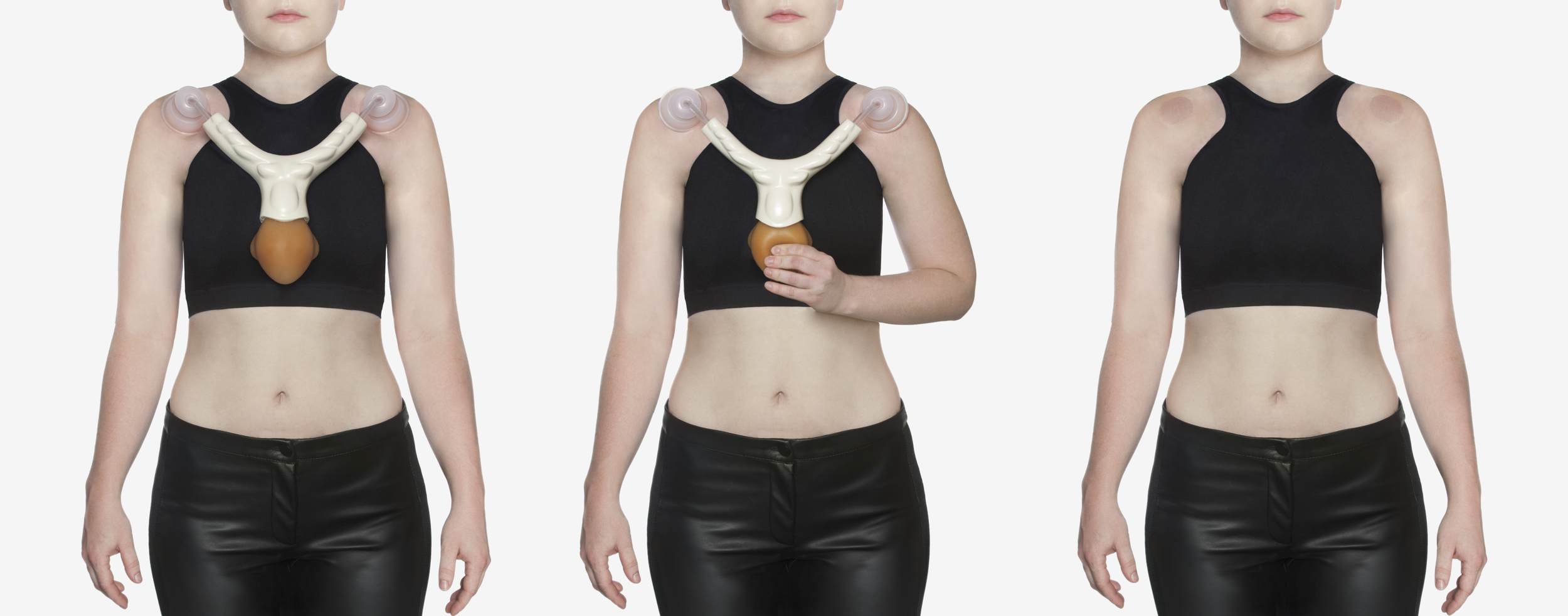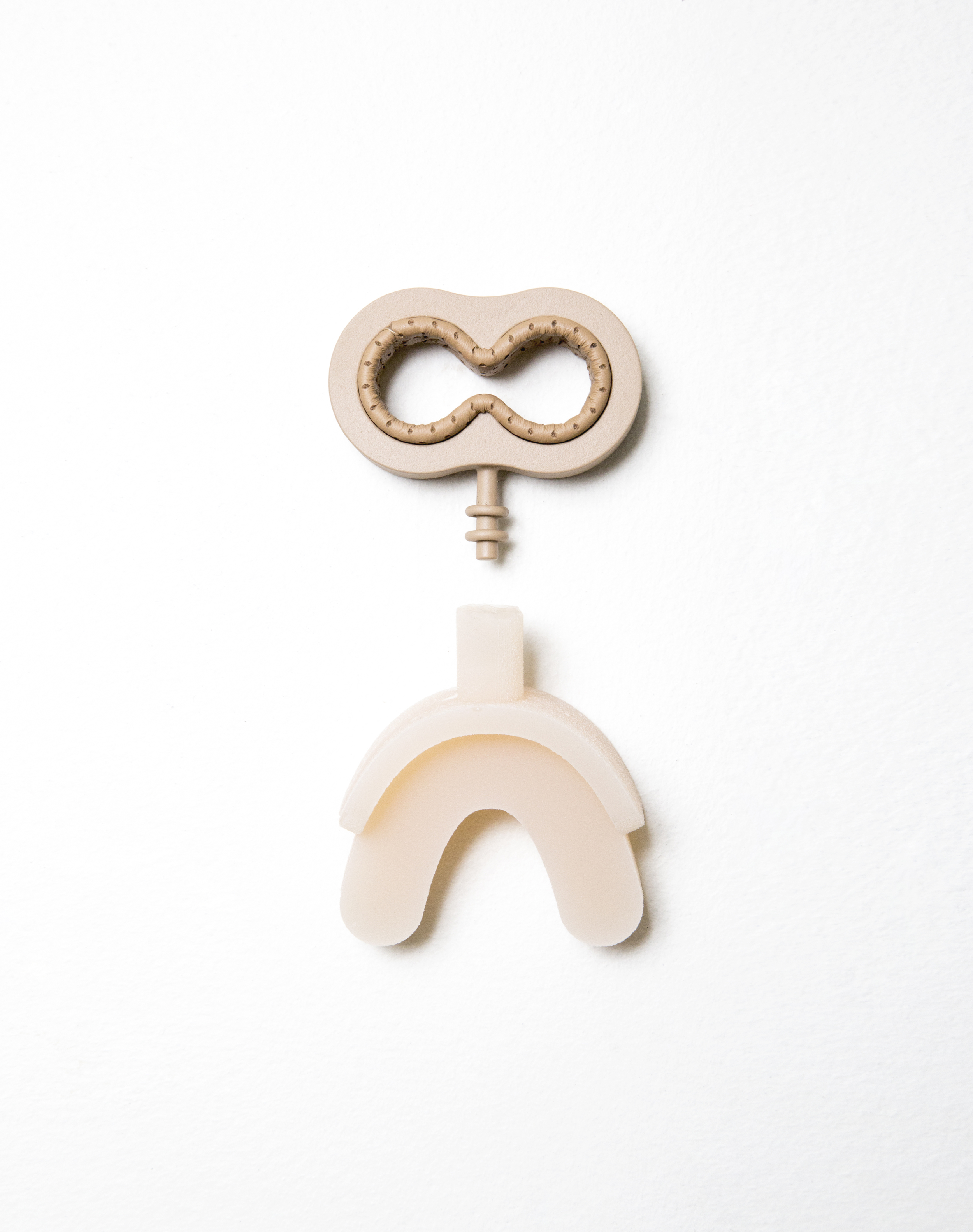Emily Culver
Emily Culver grew up in a small rural town in Pennsylvania, surrounded by the natural world that so much inspires her work. The child of a carpenter and midwife, she credits her love of working with her hands and her interest in all things curious to her upbringing. She attended Tyler School of Art, Temple University, where she received her Bachelor of Fine Arts in Metals/Jewelry/Computer Aided Design and Manufacture in 2012. Currently she lives and works in Bloomfield Hills, MI where she is pursuing her Masters of Fine Art in Metalsmithing at Cranbrook Academy of Art.
Statement
My newest work, Fetish, creates touch sensations that one may find soothing or engaging, but ultimately embarrassing to display publicly due to the erotic nature of the act or amount of pleasure derived. For example some works have push centers for massaging, others have filament-type forms that caress, and some actually suction to the body creating an enjoyable pressure. The inspiration for these objects has come from extensive material exploration in my previous works and observing subconsciously fetishized reactions to these diverse tactile surfaces.
Q&A with Emily Culver
by Sidney Mullis
What initiated your interest in creating works that provide particular sensory stimuli, such as a tickle that results in an itch or suction that leaves a light bruise?
While working on my BFA thesis I became fascinated with observing my peers reaction to certain materials that I was using, mainly silicone and rubber. They would fiddle, play and massage these objects, often without real acknowledgement of what they were doing. Eventually they would become aware that they had been carrying on a conversation all while their hands were conducting an investigative study entirely independent from their conscious stream of thought. And on a few occasions this new awareness, or perhaps the realization that I had been witness to their obsession, created a reaction of surprise or embarrassment.
So, this was what I became really interested in. How could I lure the audience into experiencing my work against their better judgement, or better how could I create an intimate experience for my audience that could be shared collectively, but retain its privacy in a sense?
You title your pieces with medical and scientific words used to describe sensations felt upon the skin. When did you begin naming your pieces in this way? Or, did the titles come first?
This process for naming really began with the new body of work. I really wanted to retain a certain amount of diplomacy, meaning that I didn't want to inhibit interaction by being overt. Therefore, I felt that creating a categorization system in this way could create a slower read of the work and allow it to exist in multiple realms of conversation.
So far, the work has come first and the titles second. By creating in this manner the process has allowed for me to observe and simulate as a way to conduct my own research. I then go and match the information that I’ve gathered to actual science.
Are your pieces accessible to be experienced in an exhibition space? If so, what responses have you received from your participants? Do they giggle? Are they embarrassed?
This is something relatively new that I'm experimenting with and trying to work out. Obviously touch is a large contributor and plays a very large part in experiencing the work. How does one create an situation in which the viewer is able to fully engage in a safe environment for both the audience and the work, specifically in an exhibition space?
Recently I participated in a group show called “Play With Me” where I installed three new works that I had made. The premise of the show was to present work in a way that it could be haptically engaged with. This exhibition, in conjunction with the group critiques that I've had (which are in a more intimate setting and function with the understanding that touching is okay), have yielded the feedback and engagement that I've been hoping for. The haptic enjoyment the work brings is so gratifying to witness and the awkward conversations that surface are full of content that is sometimes so surprising to me. People do often giggle, but what is difficult to distinguish is if is a cause of enjoyment or embarrassment as it happens as equally with the physical interaction as it does in discussion.
Would you consider these pieces jewelry? Mobile wearables? Does it matter to designate them as one or the other?
Mostly I'd say that I think of these works as not jewelry so much but as physical extensions for the body. Recently I've become a bit obsessed with the idea of prosthetics, how a foreign object becomes integrated into the physical space and concept of the body as a whole. I will say that it is entertaining for me to thinking of these as mobile wearables, as I sometimes create this fantasy in my head of what it would be like if these pieces were integrated into our everyday lives, but I don't yet know if it's beneficial to designate this work as something so finite. Rather, I think it's more productive to acknowledge the interactions that are highlighted and relate them to those that we project onto so many things in our lives; and jewelry is no exception.
You recently began your first year at Cranbrook Academy of Art. Congrats! How has it been thus far?
Being at Cranbrook has taken some getting use to but overall I am absolutely enjoying my time here. Although I do miss Philly and living in an urban area, being on this beautiful and historic campus has given me the peace and seclusion that I felt would be appreciated during my study. I also am so excited to be working with Iris Eichenberg, my Artist In Residence here, whose work I absolutely admire. The way in which she thinks and understands objects adds such a new and fresh dialogue to the conversation that I really feel that I’m engaging with my work in a new way.
You spent some time in Philadelphia and NYC prior to heading to graduate school. Was this time out of school assisting many artists and being a curatorial intern at the Museum of Arts and Design (MAD) helpful to your growth prior to the grad school plunge? Would you recommend taking time off to others transitioning out of their undergraduate programs?
When I graduated from Tyler School of Art I decided that I wanted to make myself the best graduate candidate that I could and for me that meant taking three years off to grow my exhibition and publication resume, dabble with some curatorial endeavors and gain work experience at my first salary job. These experiences gave me a taste of all sort of other avenues that I was also interested in. Although there is no right way to navigate through this part of life, I am so thankful for the time I took between undergraduate and graduate school.
What were some of the most beneficial and significant things that you learned during your time between your undergraduate and graduate career?
Most importantly I was able to test myself in a way; I've always been committed to what I do, but up until then I had always had the safe environment of school to qualify the time I was devoting to my work. The process and financial cost alone to gather tools, materials and to secure a space takes a good long while; you really have to figure out how to make ends meet. I didn't make a lot of work during these years due to these limitations and because I was working a 9 to 5, but the positive and affirming reactions that I received when it did finally come time to apply to graduate programs made the whole experience much more meaningful. In a way I felt that I had succeeded in what I had set out to accomplish.
I also took this time off to specially try to make work divorced from an academic setting. It's a known fact that programs have their own idea of what their student work should embody or the standards by which it qualifies as successful. The opportunity to function outside of this setting allowed my work to develop differently; I made work in ways that I hadn't in a long time and I had to unlearn or test some “rules” that had surprisingly become so well integrated into my practice. And so now in graduate school I'm still working hard to challenge those ideas and work outside my area of comfort.
What do you think about artist statements? Do you think it is an important element in the practice of being an artist?
I view artistic practice as an exploration of a specific singular or collective group of ideas, and therefore the artist statement functions as the verbal or written expression of this investigation. I don't know if I feel it necessary for the audience in order to engage with the work, but from my own experience I see it as a useful exercise for the artist to undertake. It can sometimes be the hardest thing to put ideas into qualifying words, but in the end it can be so enlightening.
What is the most important thing to you about your studio practice?
I’m very concerned with providing my content in a way that I feel adds something new to the conversations that circulate. I think that this is part of the reason why I’ve gravitated to the relatively newer field of Art Jewelry; I become excited by the idea that there is plenty of room to stretch my legs without treading to heavily on someone else's footsteps.
What artists are you currently interested in? What other topics, perhaps outside of the visual arts, influence you and make their way into the work?
Artists would include Lucy McRae, multiple artists from the “Design and the Elastic Mind” exhibition at MoMA, and works like Jan Svankmajer’s “Conspirators of Pleasure”.
And as I mentioned before I’m currently obsessed with prosthetics and medical/scientific instruments but also torture devices, household objects and tools, haute couture, product design, BDSM culture and sci-fi.
Anything else you would like to mention or share with us? Any projects or upcoming shows in the works?
Well recently I’ve been exploring tools, or rather the “toolness” of things. I’ve become interested in objects that occupy the hand (handheld) and have been specifically focusing on creating oral sensations. I hope to have a preview of new work posted on my website this December, please check it out and drop me a line with any thoughts!
Thanks so much for sharing your work and talking with us!
To find out more about Emily and her work, check out her website


























